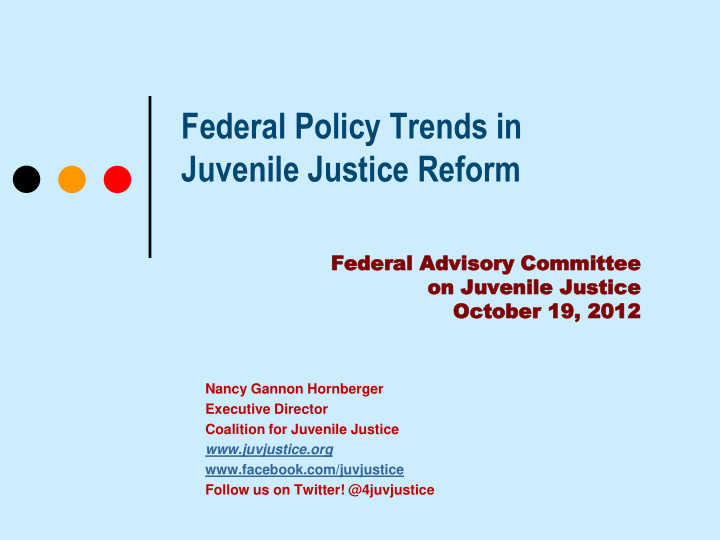



Federal Policy Trends in Juvenile Justice Reform Federa ral l Ad Adviso visory ry Co Committ mmittee on on Ju Juven venil ile Ju e Justice stice Octob Oct ober er 19 19, , 20 2012 12 Nancy Gannon Hornberger Executive Director Coalition for Juvenile Justice www.juvjustice.org www.facebook.com/juvjustice Follow us on Twitter! @4juvjustice
Swings in federal policy outlook Punitive vs. Rehabilitative Adult time for adult crime vs. Recognizing developmental and other differences between youth and adults Criminalizing adolescent behavior vs. Service, supports and interventions Institutional vs. Family and community connected care National policy leading and spurring states forward vs. national policy following on state/local innovations. 2
Limited federal role in juvenile justice and delinquency prevention Congress regards juvenile justice and delinquency ● prevention to be chiefly the responsibility of states and localities. 1970s: Marked a change: ● ● First steps to enact federal standards re: care and custody of juveniles in detention and incarceration, aimed at preventing unnecessary , dangerous and counterproductive jailing of children and youth. ● 1974: Juvenile Justice and Delinquency Prevention Act (JJDPA) marked an historic change. Still most meaningful and comprehensive federal juvenile justice and delinquency prevention statute. ● Created distinct home for juvenile justice within Department of Justice (OJJDP). 3
Exapnding federal role in juvenile justice and delinquency prevention Congress in 1980s and 1990s created new ● requirements and authorizations in abundance in juvenile justice Notable among the changes ● ● DMC (confinement) requirement ● VCO exception ● Juvenile Accountability Block Grant ● Violence Against Women Act ● New programs and highest levels of funding for juvenile justice: broad initiatives in training, research and program models; special caucuses were formed including youth leadership; many publications and robust OJJDP presence. 4
Where are we now with JJDPA? Challenges: Last reauthorization in 2002 took six years. Began on controversial and destructive footing: “The Chronic and Violent Super - predator Act ” – ended with a non-controversial, watered down bill. DMC expanded in scope but hobbled by lack of metrics and definition. Title II and Title V purposes expanded (appropriations followed suit). 5
Fast Forward: Where are we now with JJDPA? Challenges: Favorable Senate bills to reauthorize the JJDPA (due in 2007) died post Judiciary Committee-approval in the 110 th and 111 th Congress. No reauth. bill in the 112 th Congress. S. 3155 (Leahy, Kohl, Specter) S. 678 (Leahy, Kohl, Durbin) Library of Congress bill locator: http://thomas.loc.gov/home/thomas.php The House failed to act on the JJDPA or any other juvenile justice policy in the past six years. 6
Last 10-15 years – expanded legislative efforts in related areas Over time, federal legislative activity in areas ● such as: ● Runaway and Homeless Youth (RHYA) ● Re-entry: Second Chance Act ● Violence Against Women Act ● Mental health screening and assessment (MIOCRA) ● Prison Rape (PREA) Also- ● Adam Walsh Act 7
Policy innovations in addition to JJDPA to explore in past 5 years Message bills re: ● Prohibiting transfer of juveniles to criminal court (Leahy, Murphy) ● Re-classifying status offense cases as non-offenses (children in needs of services (Murphy) ● Prohibiting isolation, seclusion and restraint in schools (Casey, Miller ) ● Expanding federal support for detention reform (Ellison) ● Hotline for families and others to report dangerous or counter productive conditions in detention and corrections facilities (McCarthy) ● Prohibiting juvenile life without parole sentences for youth under federal jurisdiction (Scott) 8
Last 10+ years – administrative actions had major impact U.S. DOJ Civil Rights of Institutionalized Persons Act (CRIPA) investigations, consent decrees, monitoring and settlements addressing cruel and inhumane conditions in juvenile facilities in several states. DOJ rulings on the juvenile sex offender registery requirments DOJ ruling on “adult inmate” definition in JJDPA U.S. DOJ Civil Rights Division investigations and findings of Title VI civil rights violations, as well as due process and constitutional violations in Shelby Cty.,Tennessee and Lauderdale Cty., Mississippi. 9
Last 10+ years – Supreme Court has had major impact Abolished the juvenile death penalty Recent rulings on limiting some juvenile life without parole sentences 10
Cont. …Where are we now with current federal policy reforms? Opportunities in need of input: Youth PROMISE Act stalled o Chopped Appropriations -- Value of Formula o Fund Programs Questioned Push to pass unfunded policy o Juvenile Accountability Block Grant attracting o amendments JJDPA dormant, yet: o o Strengthened core requirements Expanded purposes for Title II to support o detention reform and attention to conditions of confinement Expanded Part D to address development of o data/evidence informed approaches 11
Cont. …Where are we now with current federal policy reforms? Opportunities in need of input: Emphasis on evidence-based practices o Caution: limiting impact on innovation and o needed adaptations for race/ethnicity, gender, rural areas, etc. o Recognition that some safeguards and positive practices are not “evidence - based” in keeping with the current, traditional definitions. Real progress is fragile in key areas o Racial/ethnic disparities o Status offender reforms o Consideration of age and stage of development o 12
Please feel free to contact me for more information at any time: Coalition for Juvenile Justice 1319 F Street, NW Ste. 402 Washington, DC 20004 202-467-0864, ext. 111 nancy@juvjustice.org 13
Recommend
More recommend